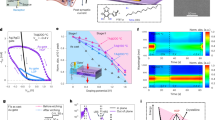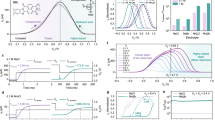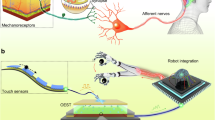Abstract
Artificial nerves that are capable of sensing, processing and memory functions at bio-realistic frequencies are of potential use in nerve repair and brain–machine interfaces. n-type organic electrochemical transistors are a possible building block for artificial nerves, as their positive-potential-triggered potentiation behaviour can mimic that of biological cells. However, the devices are limited by weak ionic and electronic transport and storage properties, which leads to poor volatile and non-volatile performance and, in particular, a slow response. We describe a high-frequency artificial nerve based on homogeneously integrated organic electrochemical transistors. We fabricate a vertical n-type organic electrochemical transistor with a gradient-intermixed bicontinuous structure that simultaneously enhances the ionic and electronic transport and the ion storage. The transistor exhibits a volatile response of 27 μs, a 100-kHz non-volatile memory frequency and a long state-retention time. Our integrated artificial nerve, which contains vertical n-type and p-type organic electrochemical transistors, offers sensing, processing and memory functions in the high-frequency domain. We also show that the artificial nerve can be integrated into animal models with compromised neural functions and that it can mimic basic conditioned reflex behaviour.
This is a preview of subscription content, access via your institution
Access options
Access Nature and 54 other Nature Portfolio journals
Get Nature+, our best-value online-access subscription
$32.99 / 30 days
cancel any time
Subscribe to this journal
Receive 12 digital issues and online access to articles
$119.00 per year
only $9.92 per issue
Buy this article
- Purchase on SpringerLink
- Instant access to full article PDF
Prices may be subject to local taxes which are calculated during checkout





Similar content being viewed by others
Data availability
Source data has been deposited in the Science Data Bank with the following link: https://www.scidb.cn/s/IVFzEr.
Change history
01 April 2025
A Correction to this paper has been published: https://doi.org/10.1038/s41928-025-01378-2
References
Kim, Y. et al. A bioinspired flexible organic artificial afferent nerve. Science 360, 998–1003 (2018).
Lee, Y. et al. A low-power stretchable neuromorphic nerve with proprioceptive feedback. Nat. Biomed. Eng. 7, 511–519 (2022).
Matrone, G. M. et al. A modular organic neuromorphic spiking circuit for retina-inspired sensory coding and neurotransmitter-mediated neural pathways. Nat. Commun. 15, 2868 (2024).
Wang, T. et al. A chemically mediated artificial neuron. Nat. Electron. 5, 586–595 (2022).
Sarkar, T. et al. An organic artificial spiking neuron for in situ neuromorphic sensing and biointerfacing. Nat. Electron. 5, 774–783 (2022).
Keene, S. T. et al. A biohybrid synapse with neurotransmitter-mediated plasticity. Nat. Mater. 19, 969–973 (2020).
Harikesh, P. C. et al. Organic electrochemical neurons and synapses with ion mediated spiking. Nat. Commun. 13, 901 (2022).
Harikesh, P. C. et al. Ion-tunable antiambipolarity in mixed ion–electron conducting polymers enables biorealistic organic electrochemical neurons. Nat. Mater. 22, 242–248 (2023).
van Doremaele, E. R. W., Ji, X., Rivnay, J. & van de Burgt, Y. A retrainable neuromorphic biosensor for on-chip learning and classification. Nat. Electron. 6, 765–770 (2023).
Wang, S. et al. An organic electrochemical transistor for multi-modal sensing, memory and processing. Nat. Electron. 6, 281–291 (2023).
Armada-Moreira, A. et al. Plant electrophysiology with conformable organic electronics: deciphering the propagation of Venus flytrap action potentials. Sci. Adv. 9, eadh4443.
Wu, W. et al. Selenophene substitution enabled high‐performance n‐type polymeric mixed ionic‐electronic conductors for organic electrochemical transistors and glucose sensors. Adv. Mater. 36, e2310503 (2023).
Yang, C.-Y. et al. A high-conductivity n-type polymeric ink for printed electronics. Nat. Commun. 12, 2354 (2021).
Cea, C. et al. Enhancement-mode ion-based transistor as a comprehensive interface and real-time processing unit for in vivo electrophysiology. Nat. Mater. 19, 679–686 (2020).
Kim, J. et al. Monolithically integrated high-density vertical organic electrochemical transistor arrays and complementary circuits. Nat. Electron. 7, 234–243 (2024).
Huang, W. et al. Vertical organic electrochemical transistors for complementary circuits. Nature 613, 496–502 (2023).
Wang, Y. et al. Acceptor functionalization via green chemistry enables high-performance n-type organic electrochemical transistors for biosensing, memory applications. Adv. Funct. Mater. 34, 2304103 (2023).
Zhang, Y. et al. Adaptive biosensing and neuromorphic classification based on an ambipolar organic mixed ionic–electronic conductor. Adv. Mater. 34, 2200393 (2022).
Khodagholy, D. et al. NeuroGrid: recording action potentials from the surface of the brain. Nat. Neurosci. 18, 310–315 (2015).
Cea, C. et al. Integrated internal ion-gated organic electrochemical transistors for stand-alone conformable bioelectronics. Nat. Mater. 22, 1227–1235 (2023).
Pandey, A. P. & Sawant, K. K. Polyethylenimine: a versatile, multifunctional non-viral vector for nucleic acid delivery. Mater. Sci. Eng.: C 68, 904–918 (2016).
Momin, M. et al. 3D-printed flexible neural probes for recordings at single-neuron level. Device 2, 100519 (2024).
Zhou, T. et al. 3D printable high-performance conducting polymer hydrogel for all-hydrogel bioelectronic interfaces. Nat. Mater. 22, 895–902 (2023).
Wang, B. et al. Face‐on orientation matches vertical organic electrochemical transistors for high transconductance and superior non‐volatility. Adv. Funct. Mater. 34, 2312822 (2023).
Frankenstein, H. et al. Blends of polymer semiconductor and polymer electrolyte for mixed ionic and electronic conductivity. J. Mater. Chem. C 9, 7765–7777 (2021).
Rivnay, J. et al. Structural control of mixed ionic and electronic transport in conducting polymers. Nat. Commun. 7, 11287 (2016).
Savva, A. et al. Balancing ionic and electronic conduction for high-performance organic electrochemical transistors. Adv. Funct. Mater. 30, 1907657 (2020).
Fabiano, S. et al. Poly(ethylene imine) impurities induce n‐doping reaction in organic (semi)conductors. Adv. Mater. 26, 6000–6006 (2014).
Wu, H. Y. et al. Influence of molecular weight on the organic electrochemical transistor performance of ladder‐type conjugated polymers. Adv. Mater. 34, e2106235 (2021).
Surgailis, J. et al. Mixed conduction in an n‐type organic semiconductor in the absence of hydrophilic side‐chains. Adv. Funct. Mater. 31, 2010165 (2021).
Sun, H. et al. Complementary logic circuits based on high‐performance n‐type organic electrochemical transistors. Adv. Mater. 30, 1704916 (2018).
Feng, K. et al. Cyano-functionalized n-type polymer with high electron mobility for high-performance organic electrochemical transistors. Adv. Mater. 34, 2201340 (2022).
Zare Bidoky, F. et al. Sub‐3 V ZnO electrolyte‐gated transistors and circuits with screen‐printed and photo‐crosslinked ion gel gate dielectrics: new routes to improved performance. Adv. Funct. Mater. 30, 1902028 (2019).
Gao, G. et al. Triboiontronic transistor of MoS2. Adv. Mater. 31, 1806905 (2018).
Cunha, I. et al. Reusable cellulose‐based hydrogel sticker film applied as gate dielectric in paper electrolyte‐gated transistors. Adv. Funct. Mater. 27, 1606755 (2017).
Hess, L. H. et al. High-transconductance graphene solution-gated field effect transistors. Appl. Phys. Lett. 99, 033503 (2011).
Zhang, S. et al. Synergistic effect of multi‐walled carbon nanotubes and ladder‐type conjugated polymers on the performance of n‐type organic electrochemical transistors. Adv. Funct. Mater. 32, 2106447 (2021).
Giovannitti, A. et al. N-type organic electrochemical transistors with stability in water. Nat. Commun. 7, 13066 (2016).
Paterson, A. F. et al. Water stable molecular n-doping produces organic electrochemical transistors with high transconductance and record stability. Nat. Commun. 11, 3004 (2020).
Chen, X. et al. n‐type rigid semiconducting polymers bearing oligo(ethylene glycol) side chains for high‐performance organic electrochemical transistors. Angew. Chem. Int. Ed. 60, 9368–9373 (2021).
Feng, K. et al. Fused bithiophene imide dimer‐based n‐type polymers for high‐performance organic electrochemical transistors. Angew. Chem. Int. Ed. 60, 24198–24205 (2021).
Tang, H. et al. A solution-processed n-type conducting polymer with ultrahigh conductivity. Nature 611, 271–277 (2022).
Li, P., Shi, J., Lei, Y., Huang, Z. & Lei, T. Switching p-type to high-performance n-type organic electrochemical transistors via doped state engineering. Nat. Commun. 13, 5970 (2022).
Bischak, C. G., Flagg, L. Q., Yan, K., Li, C.-Z. & Ginger, D. S. Fullerene active layers for n-type organic electrochemical transistors. ACS Appl. Mater. Interfaces 11, 28138–28144 (2019).
Liu, K. K. et al. J‐type self‐assembled supramolecular polymers for high‐performance and fast‐response n‐type organic electrochemical transistors. Adv. Funct. Mater. 33, 2300049 (2023).
Clapham, D. E. Calcium signaling. Cell 131, 1047–1058 (2007).
Zucker, R. S. & Regehr, W. G. Short-term synaptic plasticity. Annu. Rev. Physiol. 64, 355–405 (2002).
Catterall, W. A. & Few, A. P. Calcium channel regulation and presynaptic plasticity. Neuron 59, 882–901 (2008).
Nielsen, C. B. et al. Molecular design of semiconducting polymers for high-performance organic electrochemical transistors. J. Am. Chem. Soc. 138, 10252–10259 (2016).
Keene, S. T. et al. Efficient electronic tunneling governs transport in conducting polymer-insulator blends. J. Am. Chem. Soc. 144, 10368–10376 (2022).
Xu, J. et al. Highly stretchable polymer semiconductor films through the nanoconfinement effect. Science 355, 59–64 (2017).
Bernards, D. A. & Malliaras, G. G. Steady-state and transient behavior of organic electrochemical transistors. Adv. Funct. Mater. 17, 3538–3544 (2007).
Friedlein, J. T., McLeod, R. R. & Rivnay, J. Device physics of organic electrochemical transistors. Org. Electron. 63, 398–414 (2018).
Li, P. et al. N-type semiconducting hydrogel. Science 384, 557–563 (2024).
Wu, H.-Y. et al. Stable organic electrochemical neurons based on p-type and n-type ladder polymers. Mater. Horiz. 10, 4213–4223 (2023).
Liu, T. et al. Ground-state electron transfer in all-polymer donor:acceptor blends enables aqueous processing of water-insoluble conjugated polymers. Nat. Commun. 14, 8454 (2023).
Chen, J. et al. Optoelectronic graded neurons for bioinspired in-sensor motion perception. Nat. Nanotechnol. 18, 882–888 (2023).
Güldal, N. S., Kassar, T., Berlinghof, M., Unruh, T. & Brabec, C. J. In situ characterization methods for evaluating microstructure formation and drying kinetics of solution-processed organic bulk-heterojunction films. J. Mater. Res. 32, 1855–1879 (2017).
Acknowledgements
W.M. gratefully acknowledges funding from the National Natural Science Foundation of China (NSFC, grant W2411049), the National Key Research and Development Program of China (grants. 2024YFA1208204, 2022YFE0132400), the Key Scientific and Technological Innovation Team Project of Shaanxi Province (grant 2020TD-002) and 111 project 2.0 (grant BP2018008). S.W. gratefully acknowledges funding from the NSFC (grant 523B2033) and the China National Postdoctoral Program for Innovative Talents (grant BX20240282). B.W. gratefully acknowledges funding from the NSFC (grant 52303246) and the China Postdoctoral Science Foundation (grant. 2022TQ0250). C.Z. gratefully acknowledges funding from the NSFC (grant 22109125). P.M.B. gratefully acknowledges support from Deutsche Forschungsgemeinschaft (German Research Foundation) under Germany’s Excellence Strategy (grant EXC 2089/1–390776260, e-conversion) and TUM solar in the context of the Bavarian Collaborative Research Project Solar Technologies Go Hybrid. G.P. gratefully acknowledges support from the China Scholarship Council. G.B. gratefully acknowledges support from the Natural Science Basic Research Plan of Shaanxi Province, China (grant 2021JM-271). The GIWAXS measurements were performed at beamline P03, PETRA III, DESY. We thank A. Chumakov, H. Zhong and L. P. Spanier for their help during the beamtime. We also thank X. Guo from the Southern University of Science and Technology for help with material synthesis.
Author information
Authors and Affiliations
Contributions
S.W. and W.M. were responsible for the conceptualization of this work. S.W., G.P., S.Z., K.H., B.X., Y.B. and C.H. collected and analysed the data. Y.K. and Y.L. performed the material synthesis. X.C. undertook the cell experiments. S.W., Y.W., B.Z. and L.Y. undertook the animal experiments. P.M.B., S.V.R., Y.L., G.B., Y.H. and W.M. supervised the work. S.W. wrote the original draft of the manuscript. S.W., B.W., C.Z., G.P., P.M.B., Y.H. and W.M. reviewed and edited the manuscript.
Corresponding authors
Ethics declarations
Competing interests
The authors declare no competing interests.
Peer review
Peer review information
Nature Electronics thanks Achilleas Savva, Sihong Wang and Tao Zhou for their contribution to the peer review of this work.
Additional information
Publisher’s note Springer Nature remains neutral with regard to jurisdictional claims in published maps and institutional affiliations.
Supplementary information
Supplementary Information
Supplementary Tables 1–5 and Figs 1–39.
Supplementary Video 1
Conditioned reflex behaviour of the CMAN-implanted mouse.
Rights and permissions
Springer Nature or its licensor (e.g. a society or other partner) holds exclusive rights to this article under a publishing agreement with the author(s) or other rightsholder(s); author self-archiving of the accepted manuscript version of this article is solely governed by the terms of such publishing agreement and applicable law.
About this article
Cite this article
Wang, S., Wang, Y., Cai, X. et al. A high-frequency artificial nerve based on homogeneously integrated organic electrochemical transistors. Nat Electron 8, 254–266 (2025). https://doi.org/10.1038/s41928-025-01357-7
Received:
Accepted:
Published:
Issue date:
DOI: https://doi.org/10.1038/s41928-025-01357-7
This article is cited by
-
Building fast artificial nerves using vertical architectures
Nature Electronics (2025)



